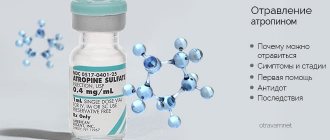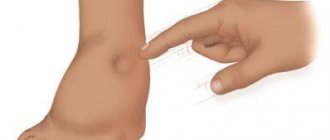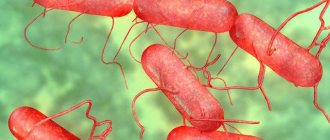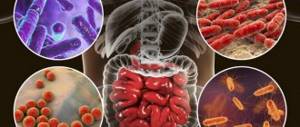Why does stool turn green?
Drinking fruit juices may change the color of your stool.
Green stool can occur in both adults and children. The main reason for this is poor nutrition.
Typically, the color of fecal matter changes due to the consumption of large amounts of food products that contain iron and artificial colors. Eg:
Black licorice Fruit juices Cereals, thoughts Saltwater fish, red meat Red beans Colored caramels Leafy greens (lettuce, dill, broccoli, spinach)
If you consumed something from the above list, then the stool may have a dark green tint for another 5 days. Bright green stool indicates the presence of a large number of additives and dyes in the food you eat.
Quite often, vegetarians have green stool, because... They include a large amount of fruits and vegetables in their daily diet, which can trigger the formation of this color.
Green color of baby's stool
An elevated temperature in a child leads to a change in the color of stool.
In the first month of life, green stool is quite normal for babies.
This occurs very often and is due to the baby’s adaptation to the environment and breastfeeding. However, the mother's panic may be justified if the following symptoms are present:
Foul odor of feces High temperature Baby’s refusal to eat
In this case, you should immediately contact your pediatrician, since the above symptoms indicate an infectious disease.
Very often, green stool occurs in infants who are experiencing teething. In this regard, the color of feces is affected by excess saliva secretion, which subsequently releases a large amount of bile, which provokes the appearance of colic in the baby’s tummy and changes the color of fecal matter.
Another reason for the formation of green stool is the use of formula milk, which is not suitable for the baby’s body. In such a situation, you can simply try a milk formula from another manufacturer.
Also, the green color of stool in newborn babies may be a residual evacuation of the first fecal formations. But this needs to be carefully monitored, since prolonged jaundice can serve as a compelling argument for examining the liver and gallbladder.
Occasionally, green feces indicate the development of dysbiosis or protein intolerance.
What can cause green stool in an adult?
Foods containing a lot of iron cause green stool in adults.
Often, the appearance of a green color in an adult's stool is caused by the use of various additives. However, without consulting a doctor.
And in vain, because many supplements not only do not bring benefits to the body, but cause damage to your health. But in general, dietary supplements have minor side effects. An adult's stool may become greenish when consumed:
Dietary supplements containing iron Laxatives Seaweed Vitamin complexes and minerals Preparations containing iodine Sorbitol Glucose
How to treat
The course of therapy will directly depend on the causative factor that provoked the appearance of green stool, and the treatment regimen should be selected on an individual basis. For example, if food products have affected the change in the color of stool, then the patient needs to reconsider his diet and, if necessary, limit or completely eliminate certain foods from it. These foods include red meat, cereals, cucumbers, and greens. It is recommended to avoid products containing food dyes. To cleanse the body of harmful substances, doctors prescribe Regidron, Smecta, Atoxil and other drugs.
"Regidron"
If the cause of the change in stool color is infectious diseases, then self-medication is strictly not recommended. After determining the severity of the pathology, the doctor prescribes antibacterial and anti-inflammatory drugs. Often, a change in stool color is accompanied by severe diarrhea, which increases the likelihood of dehydration (along with feces, beneficial salts and minerals are washed out of the body, which significantly worsens the patient’s condition). To restore losses, experts recommend drinking a lot of liquid with added sugar and salt (for 1 liter of water - 1 teaspoon of salt and sugar).
Treatment of diarrhea
Also, the appearance of green stool may be accompanied by bouts of vomiting, which indicates food poisoning in the body. In this case, it is necessary to rinse the stomach, freeing it of food. To rinse, the patient must drink a large amount of warm boiled water. It is necessary to drink until the urge to vomit appears (to speed up the cleansing of the stomach, you can use a weak solution of potassium permanganate). Acute pain on the left under the ribs in front, study the link.
Pathological causes of the formation of green feces in adults and children
There can be many reasons that provoke the appearance of green fecal matter. Most of them indicate a disturbance in the functioning of the intestines or other organs.
It is noteworthy that the bile secreted by the gallbladder is bright green. As it passes through the intestines, the color of the bile becomes darker and eventually its color becomes dark brown.
But there is one “but”: if bile moves through the intestines quite quickly, then its color simply does not have time to change its color, and it remains green. The most common reasons for the rapid movement of bile through the intestines:
Giardia Salmonellosis Food poisoning Food allergy Rotavirus infection Crohn's disease Celiac disease Ulcer in the gastrointestinal tract Diabetes Inflammatory process in the small intestine Thyrotoxicosis
These are just some of the reasons why a person may have green fecal matter. You should immediately consult a doctor if green stool is accompanied by pain in the small or large intestine, as well as increased body temperature and vomiting.
Most often, the manifestation of such symptoms occurs during the development of an infection or during an inflammatory process. A striking example of this is a disease such as enterocolitis. In the presence of such a disease, fecal matter may not only be green, but also be accompanied by purulent discharge and mucus. This is due to the death of leukocytes.
The following video will tell you about the appearance of green feces:
Patients often complain of pain in the peritoneum and diarrhea. If these symptoms are detected, it is necessary to provide the patient with therapeutic fasting. Support for the body can be provided by taking medications such as Smecta, Regidron, Humana-electrolyte, etc. Therapeutic fasting should be observed during the first day of detection of symptoms.
On days 2–3, it is possible to change the therapeutic fasting to a more gentle diet. In extreme cases, the patient may need medical attention in the form of intravenous saline.
You also need to pay attention to other symptoms that may occur with dysbiosis. These include:
Bloating Frequent belching Pain in the abdominal area Increased gas production
This often occurs in people undergoing antibiotic therapy to combat certain diseases. But this also kills the beneficial intestinal microflora. In this case, the feces will have a foul odor. The definition of the disease can be determined by conducting a detailed stool analysis for dysbacteriosis.
The disorder can also be caused by a duodenal or gastric ulcer. To get confirmation or refutation of the alleged diagnosis, you need to contact a gastroenterologist. Typically, a gastroenterologist prescribes an examination called fibrogastroendoscopy.
What to do if you find green fecal matter?
If green stool appears, you should contact a gastroenterologist.
If you develop green stool after eating specific foods that cause green stool, or after taking medications or supplements, you will not need treatment.
It is enough to simply exclude provocateurs from your daily diet and after 2-3 days the situation will stabilize.
Otherwise, treatment cannot be avoided. If you notice any suspicious symptoms, immediately consult a doctor. Do not delay so as not to aggravate the situation. After all, if fever, diarrhea, constipation or vomiting occurs, it will be much more difficult to restore the body.
If you find not only green color but also bloody streaks in fecal waste, then immediately go to the clinic. In this case, the person urgently needs medical help, because... Failure to prevent the disease in a timely manner can lead to dehydration. In this case, the patient will be given assistance in the form of intravenous administration of saline and glucose. This helps maintain water balance in the body.
Also, if the disease is at an advanced stage, the patient will be prescribed medication.
If you are not a vegetarian and do not take dietary supplements, but you experience green stool, you will need to consult a doctor. Such a problem should be addressed to a therapist and gastroenterologist, and the child, first of all, should be shown to a pediatrician. In some cases, a person may need surgery.
Tell your friends!
Share this article with your friends on your favorite social network using social buttons. Thank you!
The normal color of stool is brown. They are colored this color by bile pigments. A dark green tint can be caused by foods that a person consumed the day before. Changes in the color and consistency of fecal matter indicate possible pathological changes in the body.
Recommendations
If you notice any changes in your stool, do not despair. You need to calmly figure everything out, and if necessary, resort to additional diagnostic methods (laboratory, instrumental studies) and the help of qualified specialists. They will be able to make a definitive diagnosis and prescribe effective treatment if necessary.
Children's problems are perceived with the greatest trepidation, but fortunately, most often they are not serious. They consist of irrational nutrition, and for healing you just need to choose the right diet. And in good condition, just observation is enough, and after a few days the stool will recover on its own.
Causes and possible diseases
Dark green color of stool can be caused by physiological or pathological reasons
Both adults and children can have green stools. The main reason is poor nutrition. Green coloring of fecal matter occurs when eating foods containing dyes and iron. Such products are: fruit juices, sea fish, lettuce, broccoli, red beans, black licorice, etc.
When consuming some of the above foods, the color of the stool may change within 5 days. A dark green tint to stool is usually observed in vegetarians, since their diet is dominated by vegetables and fruits.
Dark green stool may indicate certain pathologies. This shade of stool appears against the background of bleeding in the stomach or intestines. This may indicate a peptic ulcer or cancer processes in the body. Green stool may indicate the development of dysentery; treatment in this case is carried out only in a hospital.
Useful video - What green stool indicates:
Dark green stool can occur due to dysbiosis. Digestive microorganisms die in the small intestine, resulting in processes of rotting and fermentation. Typically, dysbiosis develops with long-term use of antibiotics.
Other possible causes of changes in stool color:
Poisoning Rotavirus infection Crohn's disease Salmonellosis Inflammation of the small intestine Ulcerative colitis Lactose and fructose intolerance
In addition, dark green stool may indicate a lack of pancreatic enzymes.
Symptoms and complications
Changes in the color of stool are always an alarming sign that requires examination and identification of the cause.
With dysentery, in addition to changes in the color of stool, the patient experiences the following symptoms:
Weakness Nausea Vomiting Fever Abdominal pain
If the color of the stool persists for several days, and the patient complains of abdominal pain and fever, then you should immediately consult a doctor. In addition to the above symptoms, stool upset, weight loss, and putrid smell of stool may be observed. In this case, you will need to be tested for the presence of E. coli, Shigella and other pathogenic microorganisms in the body.
If you experience bloating, frequent belching, or increased gas production, then such symptoms indicate dysbacteriosis.
Diet
An important point in the treatment of green diarrhea is the organization of the diet. The diet should be as light and gentle as possible, helping to relieve the digestive system. It is important to pay attention not only to the composition of the diet, but also to some other important nuances.
The patient needs:
- Drink enough fluids. It is best to drink regular boiled water in small sips. When the condition normalizes a little, you can add tea and dried fruit compote.
- Eat in small portions, at least 4 times a day.
- Consume foods that have been heat-treated (for example, raw vegetables and fruits can cause irritation in the intestines and aggravate the course of the disease).
- Pay attention to the consistency of the dishes. Products should be soft, crushed, best in the form of cream soup or puree.
Recommended Products
The patient's diet should include:
- Dried bread, biscuits, diet bread.
- Berry jelly (for example, blueberry jelly).
- Tea (it is best to give preference to black teas).
- Herbal decoctions (for example, bird cherry decoction).
- Cereal porridges (rice, oatmeal), cooked in water without adding oil or spices.
- Boiled fish of low-fat varieties (best in the form of steamed meatballs).
- Dietary meats (boiled chicken breast, white turkey meat). The product is pre-boiled and crushed.
- Boiled vegetables in the form of puree.
- Baked fruits (eg apples, bananas).
Prohibited Products
The list of foods that are prohibited during the development of liquid green stools is very long.
The patient is not recommended to use:
- Fatty foods that are difficult to break down by enzymes produced in the body (especially with enzyme deficiency, observed in pancreatitis, hepatitis).
- Fermented milk products that increase the intensity of fermentation processes in the intestines (with the exception of products containing beneficial microflora).
- Semi-finished products and fast food products that contain a large number of artificial additives (flavors, dyes, flavor enhancers, preservatives).
- Freshly squeezed fruit juices, irritating the mucous membrane of the digestive system.
- Dishes with a high content of salt, spices, pickled foods.
- Mushrooms.
- Legumes.
- White cabbage and vegetables with a pronounced bitter or pungent taste (radish, garlic, onions or green onions).
- Carbonated and alcoholic drinks, strong coffee, milk.
Dark green stool in a child
Black-green feces in a newborn are considered normal during the first month of life.
Then it should change and eventually have a light brown tint. Color may change when switching to artificial feeding. Iron, which enters the body in excess quantities, can give the stool a green tint. If the child is breastfed, then the reason for the change in the color of the stool should be sought in the mother's diet.
A change in stool can be observed when the first teeth erupt. The baby puts everything in his mouth and many things may not be sterile. They contain various bacteria. As a result, not only the color of the stool may change, but this can lead to various diseases.
The dark green color of a child's stool may indicate the development of dysbiosis.
This is usually observed with long-term use of antibiotics, which kill intestinal microflora. This disease is characterized by green feces with a rotten smell.
There is no need to worry if your baby has loose, foamy green stools with mucus. This is considered the norm. The baby sucks out the foremilk, but cannot reach the fatty milk. If such stool has an unpleasant odor and the child is bothered by pain, then this indicates a pathology and you should contact your pediatrician and undergo the necessary tests.
Diagnostics
A coprogram is a study of the physical, microscopic and chemical characteristics of feces
To diagnose and identify the cause of this symptom, an examination is carried out. Laboratory methods include coprogram, microscopic examination, bacterial culture of stool, blood and urine tests.
Coprogram is a non-invasive and informative method for examining feces, thanks to which you can study the microscopic composition of feces: red blood cells, leukocytes, fibers, crystals, etc. In addition, you can study the chemical composition: content of hemoglobin, fat, pigments, protein, etc. Deviations in the coprogram may indicate the degree of damage to the intestines and stomach.
A microscopic examination is carried out if parasites are suspected.
The study uses a polymerase chain reaction to isolate parasite DNA. Thanks to a detailed analysis, it is possible to identify parasites at any stage of their life cycle.
Tank analysis helps to identify pathogens of intestinal infections, microflora, and bacteria. The biomaterial is placed in a special environment, as a result of which the causative agent of the disease and susceptibility to antibiotics are identified.
Features of treatment
Only after identifying the cause of the change in stool color can the doctor prescribe effective treatment
If the change in the color of stool is associated with poor nutrition and eating certain foods, then it is necessary to exclude them from the diet and within a few days the stool will return to normal. If there are no other symptoms, then treatment will not be needed.
After diagnosis and determination of the cause of the change in stool color, treatment is prescribed.
To eliminate diarrhea and cleanse the stomach of toxins, Smecta, Regidron, Enterosgel, etc. are used. At the same time, symptomatic therapy is carried out. When the temperature rises, antipyretic drugs are used, and for cramps and abdominal pain, painkillers are used. When intestinal infections are detected, antimicrobial drugs are prescribed. Sorbents are used to remove toxins from the body. Antibacterial drugs to suppress pathogens are prescribed penicillins, cephalosporins, tetracyclines, etc. The course of administration should not be less than 7-10 days. In case of dysbacteriosis, to restore the intestinal microflora, drugs containing lacto- and bifidobacteria are prescribed: Bifidumbacterin, Bifiform, Linex, etc. To boost the immune system and accelerate the restoration of intestinal microflora, the use of immunomodulators is recommended: echinacea tinctures, Dibazol, etc.
During treatment, you should avoid eating “harmful” foods: smoked and pickled foods, fried and fatty foods, mushrooms, potatoes, pasta, etc.
It is also not recommended to consume foods that increase gas formation: white bread, milk, bananas, sweet and flour products. This will reduce the load on the intestines. After the course of treatment, a repeat stool test is taken.
Noticed a mistake? Select it and press Ctrl+Enter to let us know.
In a healthy adult, the color of stool is brown, with variations in shades. The color is due to the presence of stercoblin pigment; depending on its concentration, the color can be darker or lighter.
This indicator is greatly influenced by diet, as well as taking certain medications, especially those that contain iron. Unnatural greenish-black, red, gray and other shades are signs of the presence of ulcers, pancreatitis, hepatitis and other diseases.
If you detect dark stool, you need to carefully analyze your diet over the past few days. Black stool resulting from the use of medications and foods does not cause any harm to health and does not require treatment.
Within a few days, the color of the stool should normalize, provided that provoking foods are excluded from the diet. In this article we will determine whether black feces are a sign of something dangerous in an adult or not.
Treatment options
Depending on the intensity of diarrhea and the presence of other accompanying symptoms, the patient is prescribed a certain type of therapy (or various treatment methods are used in combination).
Types of assistance:
- Use of medications. If a patient is diagnosed with an infectious disease affecting the abdominal area, he is prescribed antibiotics. In addition, sorbents are recommended, as well as agents that suppress the manifestations of flatulence. The duration of therapy in this case is 1–2 weeks.
- Normalization of intestinal microflora. For these purposes, prebiotics and probiotics are used. These can be both medications and various food products (for example, Acidolact, natural homemade yoghurts).
- Restoring fluid balance in the body. With profuse diarrhea, the human body loses a large amount of water. And without it, internal organs and systems cannot fully function. To make up for losses, the patient needs to adjust fluid intake. But drinking regular drinks leads to even greater dilution of stool, so if you have severe diarrhea and signs of dehydration, you need to drink special pharmaceutical solutions (for example, Regidron).
- Taking enzyme preparations. These remedies are necessary if diarrhea was caused by a malfunction of the pancreas or liver. In this case, food is digested worse and moves through the intestines. This leads to stagnation of the food bolus, the development of rotting processes, as a result of which the feces acquire a characteristic color.
- Surgery. This method of treatment is indicated in the presence of internal bleeding in the area of the digestive organs. Most often, the patient is prescribed minimally invasive surgery using a laparoscope.
- Diet and lifestyle correction. It is necessary to give up alcohol and other bad habits, as well as difficult to digest foods that cause fermentation processes in the intestines.
First aid
It is important to begin drug therapy as soon as possible, including taking antibiotics, sorbents, antiemetics, antipyretics (if necessary), as well as special solutions to restore water and electrolyte balance. You can drink boiled water, but you should not drink it in one gulp; it is best to take several sips.
Also, in the first 3 days after the problem appears, it is necessary to follow the most gentle diet possible. The patient is recommended to eat only dried bread and tea (a small amount of sugar can be added to it). When the patient's condition improves a little, you can diversify his menu by adding rice water, and then boiled rice, mashed potatoes (or any other vegetable) without oil and spices.
The patient needs to remain in bed and refrain from physical activity. In addition, it is necessary to call an ambulance as soon as possible.
What causes black stool in adults?
In a healthy person, black feces may appear due to the fact that he has eaten large quantities of foods that contain a coloring fat-soluble substance. These include:
blood sausage; liver; Red beetroot; meat products containing an admixture of animal blood; tomatoes; black currant; prunes.
In adults, this phenomenon can also be observed after consuming:
chokeberry; blueberries; red grapes; grenade; red wine with added dyes.
Traditional treatment
It is possible to eliminate the manifestations of pathology and normalize the patient’s condition using traditional medicine. It is important to remember that traditional therapy is only an auxiliary method that complements the main treatment.
St. John's wort decoction
To prepare you will need:
- dried flowers and leaves of the plant (1 tbsp.);
- boiling water (300 ml);
- natural liquid honey (1-2 tsp).
To prepare the product, you need:
- Grind and dry the raw materials.
- Pour boiling water over it.
- Heat in a water bath for 10 minutes.
- Leave until the product cools down to a comfortable temperature.
- Strain thoroughly.
- Add honey, stir.
The drug is taken half an hour before meals, 100 g 3 times a day.
Wormwood infusion
Required ingredients:
- wormwood leaves (1 tbsp.);
- boiling water (1 cup);
- sugar (small amount, no need to add).
Preparation:
- The raw materials are poured with boiling water.
- Boil over low heat for 10 minutes.
- Leave until completely cooled, strain.
- If necessary, add 1 tsp. Sahara.
The infusion should be taken several sips throughout the day.
Walnut infusion
To prepare you will need:
- walnut kernels (2 tbsp.);
- boiling water (400 ml);
- honey (1 tsp).
To prepare the decoction you need:
- Grind the nut kernels to a powder.
- Pour boiling water over them.
- Cook over low heat for 15 minutes.
- Cool, strain.
- Add honey.
Take the decoction 2-3 times a day shortly before meals.
Oak bark decoction
To prepare the product, you need to take:
- crushed oak bark in the amount of one tablespoon (raw materials can be purchased at the pharmacy);
- boiling water (one glass).
Cooking steps:
- The raw materials are poured with boiling water.
- Place on low heat and boil for 15 minutes.
- Cool to room temperature and strain.
The decoction is taken 50 ml three times a day.
Blueberry jelly
To prepare you will need:
- blueberries (250 g);
- water (2 l);
- starch (4 tbsp);
- lemon juice (2 tbsp);
- sugar (small amount).
Cooking steps:
- The berries are thoroughly washed and filled with water.
- Place on low heat, add sugar and lemon juice, and cook until tender.
- After this, the broth is filtered, the berries are crushed to a porridge state.
- The raw materials are sent back to the pan.
- Add starch, after diluting it with cold water, cook the jelly until thickened.
- Remove from heat, cool.
You can take the product 1-2 glasses per day.
Effect of medications
Constant use of non-steroidal anti-inflammatory drugs (Aspirin, Ibuprofen, etc.), which are prescribed for joint diseases, if the conditions of administration are not observed, often cause microerosions of the gastric mucosa, which bleed, turning the stool dark.
Also, stool may turn black when taking medications that contain a lot of iron. They are mainly used to treat anemia. This also includes drugs that contain bismuth or activated carbon. In both the first and second cases, there is no need to resort to treatment. Simply eliminate foods and medications from your diet that may cause unusual stool color.
Chronic pancreatitis, its manifestations and directions in therapy
Pancreatitis is inflammation of the pancreas tissue. Rarely does anyone think about the health of this organ. Meanwhile, it is he who produces the enzymes necessary for the digestion process. It synthesizes the most important hormone in the human body - insulin. The pancreas determines how well the food will be digested, because if not enough enzymes are released, pieces of undigested food may remain in the stool and it will be light in color.
In order to diagnose pancreatitis, it is necessary to undergo an ultrasound. The organ will be enlarged, or the doctor will notice areas of inflammation in the tissues. Treatment methods involve taking enzymes from outside in order to neutralize their production by the gland. Reviews about this treatment are positive. It is especially effective if you adhere to a therapeutic diet: exclude fatty foods, heavy meat, fast food and alcoholic drinks. You should follow the drinking regime and drink as much clean liquid as possible.
Black feces as a sign of disease in adults
If black stool appears suddenly, you should look for the reasons for this phenomenon in the gastrointestinal tract.
Such a clinical symptom may indicate gastrointestinal bleeding from the upper digestive tract, for example, with acute peptic ulcers, neoplasms in the stomach or cirrhosis accompanied by esophageal varices.
You should not think that in this case the feces must contain blood: in the digestive tract, blood is processed by enzymes and bacteria along with food, coagulates and changes color from red to black.
Typically, this cause of black stool is not accompanied by this symptom alone. One of the accompanying human conditions can also indicate internal problems:
temperature; nausea; vomit; pale skin; cold profuse sweat; enlarged and painful liver; stomach pain.
Also, internal bleeding may be indicated by a low hemoglobin level during a general blood test or detection of occult blood during a stool test. If any of these symptoms occur in combination with the appearance of black stools, you should immediately consult a doctor.
Diagnostic techniques
If a person experiences prolonged green diarrhea (especially if their diet has remained the same and there are additional unpleasant symptoms), this requires immediate medical attention. It is necessary to establish the exact reason for this development of the situation and eliminate it.
For this, various diagnostic techniques are used:
- A survey of the patient, during which the doctor establishes how long ago the problem occurred and other important circumstances (the number of bowel movements, the nature of the stool).
- Analysis of stool to determine its structure, the presence of foreign impurities in it, such as mucus, blood, undigested food fragments, fatty elements.
- Ultrasound (ultrasound examination) of the digestive organs to identify possible damage.
- Gastroscopy to determine epigastric diseases.
- Colonoscopy to evaluate the condition of various parts of the intestine.
Black stool during pregnancy, why?
As for pregnant women, all multivitamin complexes for pregnant women contain iron, which colors the stool. This is considered normal and does not require additional measures.
At the same time, doctors assure that this is how excess iron leaves the body, so you should not stop taking vitamins. The body simply absorbs the amount that mother and child need, and sends the excess to waste. In the following article you will learn why incontinence occurs. Therefore, if no other symptoms are observed, then there is no need to worry, and in order to calm yourself down, you just need to stop taking vitamins for a couple of days and make sure that your stool returns to normal.
It’s another matter if black feces during pregnancy are not associated with vitamins. In this case, you need to urgently consult a doctor to get all the necessary tests.
List of possible physiological causes
Light brown feces may appear if the patient has overeaten a particular product, or as a reaction of the digestive system to an unusual ingredient in a dish. Therefore, first of all, you need to remember what you ate last week and not panic.
Here is a list of foods that in some cases can cause light brown stool in an adult:
- white unpolished rice (and dishes made from it: rolls, sushi, pilaf, porridge);
- fermented milk products and milk more than a liter per day;
- baked goods made from white flour;
- boiled peas (more than a kilogram per day);
- barley and dishes made from it.
What to do with such a problem?
Of course, before starting any therapeutic measures, you should find out why the stool turned black.
If the dark color of the stool is associated with the nature of the diet or taking medications, then there is no need for therapeutic measures. Also, you should not stop treatment with medications and exclude coloring products, because a change in stool color in this situation does not lead to any negative effect on the body.
Black stool itself is not dangerous. But it can signal serious problems in the body, even conditions that can lead to death in the absence of timely help.
On the other hand, everything is often explained by the banal consumption of certain foods, which color the feces in an unusual color. In any case, you shouldn’t “disdain” studying the state of your own stool, and even more so you shouldn’t ignore its changes.
Nature is wise - it has provided a whole system of signals and markers that should make a person think about whether everything is okay with him.
Prevention
To reduce the likelihood of developing an unpleasant and delicate problem, you must follow simple prevention rules. You need to wash your hands after visiting the toilet or going outside, and avoid contact with potential sources of infection. You also need to adhere to the principles of a healthy diet, eat food often, but little by little, and choose only high-quality products. Another important point is giving up bad habits, strengthening the immune system, and moderate physical activity. In addition, it is necessary to promptly identify and eliminate various diseases that affect the organs of the digestive system.
What does black-green stool mean?
Black-green feces always indicate trouble in the human body. Thus, liquid black-green stool (diarrhea) most often indicates an intestinal infection or other infectious disease. Very often, dysentery begins with black-green diarrhea.
Such black-green diarrhea at the very beginning of the development of the disease may not be combined with a rise in temperature, abdominal pain, nausea and other symptoms of infection. But gradually, the listed clinical symptoms of infection will join the liquid stool, colored black and green.
Therefore, as soon as a person notices the discharge of black-green liquid stool, it is necessary to urgently seek medical help and not wait for the temperature to appear, since the condition will worsen in the future, and the infectious disease will still require treatment.
Chronic cholecystitis and cholelithiasis
It usually occurs after the formation of sediment or stones in the gall bladder. In some cases, the disease can be triggered by an abnormal physiological shape of the organ - if there are bends on it, then cholecystitis is regarded as a normal condition. To avoid pain and problems with digestion, you need to take a course of choleretic drugs from time to time.
“Urossan” has proven itself to be excellent in this situation - it has a mild choleretic effect, and the hepatoprotective effect supports the functioning of the body. Already in the second week of taking the capsules, the color of the stool will normalize and the patient will feel more alert and efficient.









